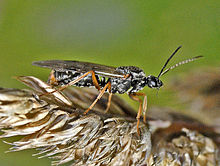The Formica rufa group is a sub-generic group within the genus Formica, first proposed by William Morton Wheeler. This group contains the mound-building species of Formicacommonly termed "wood ants" or "thatch-mound ants", which build prominent nests consisting of a mound of grass, litter or conifer needles. The species Formica rufa or the red wood ant is the type species of this sub group.
This particular breed of ant can inhabit open wood with both hard and soft woods, dense pine forests, and even moor land. Workers are polymorphic, the largest reaching about 10 millimetres long. They can produce formic acid in their abdomens and eject it 12 centimetres in the air when threatened. The only function of males is to mate in flight with queens. Species previously attributed to the Microgyna group were transferred to the Rufa group by the Wheelers in 1986.
Colonies
The genetic relations in F. rufa group colonies can be complex. Colonies can be polygynous (having multiple queens) and these are often polydomous (having multiple nests per colony). Queens may be singly or multiply mated, and in polygynous colonies may or may not be related. Colonies are rarely, if ever, independently formed. They either bud off from existing colonies, or are formed by temporary social parasitism of F. fusca colonies; a rufa queen ousts the existing queen, lays eggs, and the fusca workers raise her offspring until the nest is taken over. Some species in the F. rufa group sometimes form enormous "supercolonies" consisting of hundreds or thousands of nests. The largest documented example is an F. yessensis colony in Japan covering 2.7 km2 containing an estimated 306 million workers and 1 million queens.

Members of Species
References
This particular breed of ant can inhabit open wood with both hard and soft woods, dense pine forests, and even moor land. Workers are polymorphic, the largest reaching about 10 millimetres long. They can produce formic acid in their abdomens and eject it 12 centimetres in the air when threatened. The only function of males is to mate in flight with queens. Species previously attributed to the Microgyna group were transferred to the Rufa group by the Wheelers in 1986.
Colonies
The genetic relations in F. rufa group colonies can be complex. Colonies can be polygynous (having multiple queens) and these are often polydomous (having multiple nests per colony). Queens may be singly or multiply mated, and in polygynous colonies may or may not be related. Colonies are rarely, if ever, independently formed. They either bud off from existing colonies, or are formed by temporary social parasitism of F. fusca colonies; a rufa queen ousts the existing queen, lays eggs, and the fusca workers raise her offspring until the nest is taken over. Some species in the F. rufa group sometimes form enormous "supercolonies" consisting of hundreds or thousands of nests. The largest documented example is an F. yessensis colony in Japan covering 2.7 km2 containing an estimated 306 million workers and 1 million queens.

Typical Formica thatch mound made of forest litter on rotten stump, covered by worker ants going out to forage.
Members of Species
European species include:
- Formica aquilonia Yarrow (1955)
- Formica lugubris Zetterstedt (1838)
- Formica paralugubris Seifert (1996)
- Formica polyctena Förster (1850)
- Formica pratensis Retzius (1783)
- Formica rufa Linnaeus (1761)
North American species include:
- Formica ciliataMayr (1886)
- Formica coloradensis Creighton (1940)
- Formica comata Wheeler (1909)
- Formica criniventris Wheeler (1912)
- Formica dakotensis Emery (1893)
- Formica fossaceps Buren (1942)
- Formica integra Nylander (1856)
- Formica integroides Emery (1913)
- Formica laeviceps Creighton (1940)
- Formica microgyna Wheeler (1903)
- Formica mucescens Wheeler (1913)
- Formica obscuripes Forel (1886)
- Formica obscuriventris Mayr (1970)
- Formica oreas Wheeler (1903)
- Formica planipilis Creighton (1940)
- Formica propinqua Creighton (1940)
- Formica ravida Creighton (1940)
- Formica reflexa Buren (1942)
- Formica subnitens Creighton (1940)
References
- Gösswald, Karl (1989). Die Waldameise 1. Wiesbaden: Wiesbaden : Aula-Verlag. ISBN, 3-89104-475-5.
- ^ a b Dr Timothy Batchelor Msu.edu - Southern red wood ant Formica rufa.
- ^ a b c d e Bourke, Andrew F. G.; Nigel Rigby Franks (1995). Social Evolution in Ants. Princeton University Press. p. 353. ISBN 0691044260.
- Wikipedia







No comments:
Post a Comment